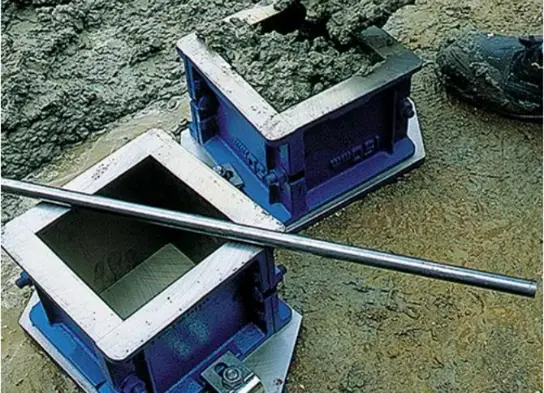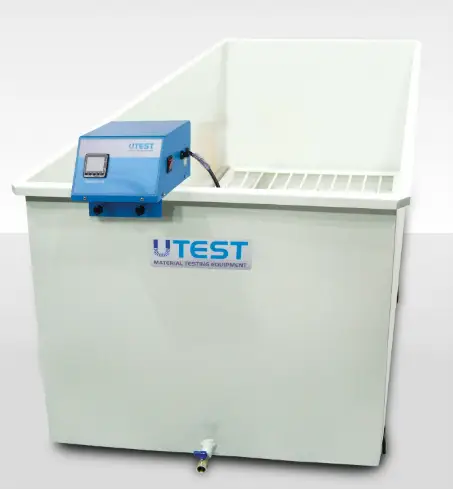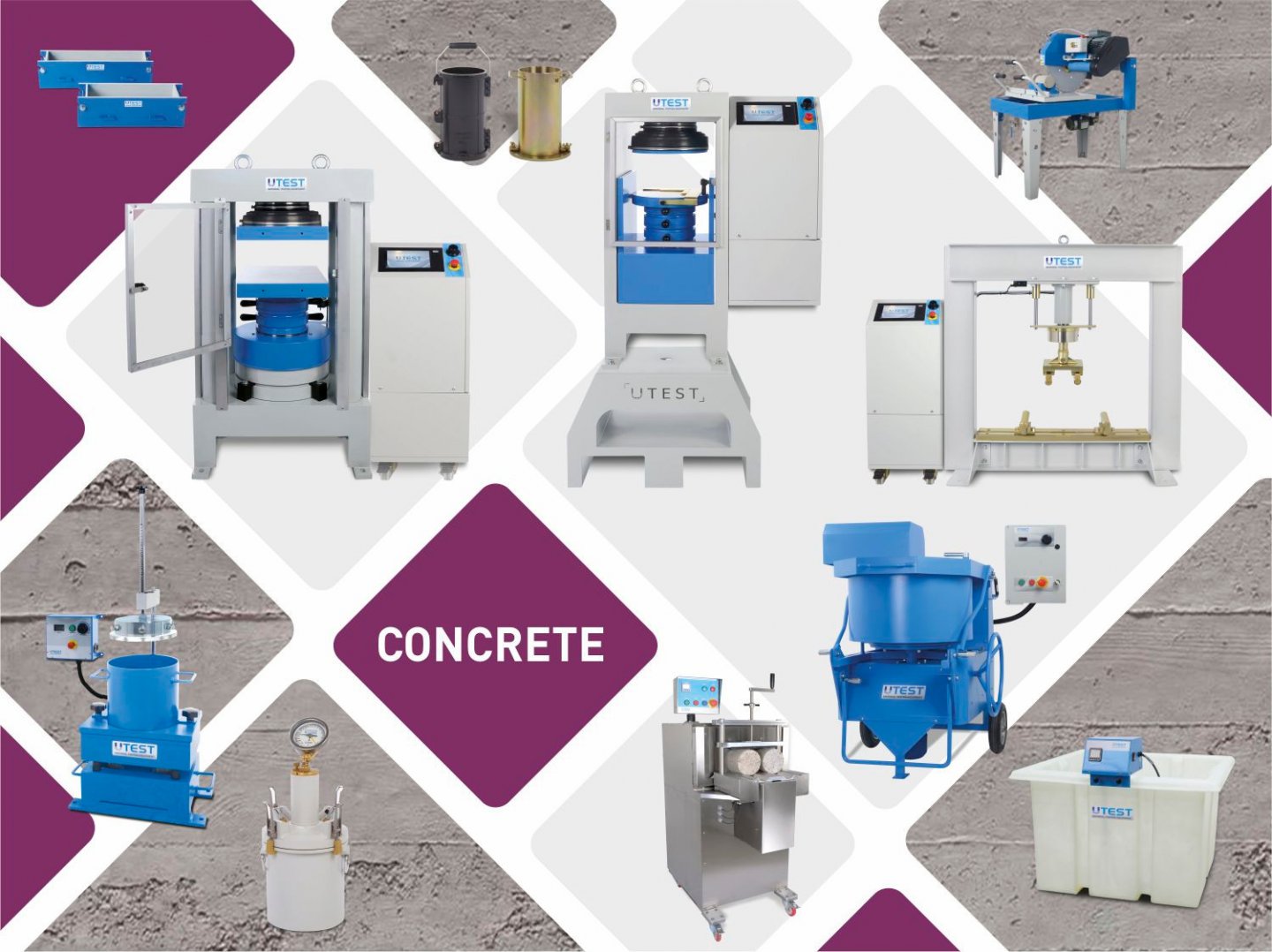Compressive Test
Some Concrete Specification Requires The Compressive Test Strength for Both 7 Days and 28 Days. Why?
7-day compressive strength test results are usually not used for acceptance purpose but for information only. Instead, 28-day compressive strength test results are commonly adopted for acceptance purpose.
7-day compressive strength test results are often used to monitor the gain of early strength and they are estimated to be about 64% to 70% of the 28-day strength. As such, it serves as a warning signal to both concrete producers and contractors should the 7-day compressive strength test results are far less than 75% of the 28-day strength. Nowadays, most concrete placement schedule is very tight and it is of paramount importance for contractors to get to know as soon as possible the occurrence of low 7-day compressive strength test results. As such, the contractor could implement suitable measures promptly to get better quality control procedures at construction site and to monitor closely on sampling, molding, and testing of the test cubes so as to avoid the recurrence of the production of low-strength concrete in the coming concrete batches.
Cube Testing: Compressive Strength of Concrete Explained
- Cube testing is essential for verifying the compressive strength of concrete and ensuring construction project safety, quality, and reliability.
- The concrete cube test involves preparing specimens with even load distribution before compression testing to determine their compressive strength.
- Factors such as water-cement ratio, aggregate type, and curing conditions affect the compressive strength of a material or structure.
The Importance of Cube Testing in Construction
Concrete cube testing is a crucial aspect of the construction industry, as it guarantees the quality, safety, and dependability of concrete employed in commercial and industrial structures. Compressive strength, which is the capacity of a material or structure to sustain loads without fracturing or deformation, is of paramount importance in determining the structural integrity of a building.
Conducting a concrete cube test allows for the verification of the concrete’s compliance with its anticipated compressive strength, helping to circumnavigate potential disasters.
Ensuring Quality Control
Cube testing, a method of testing hardened concrete, is essential for maintaining absolute certainty in regards to the quality of the material. Employing a supplier that conducts cube tests instills confidence in the concrete used for your project meeting the necessary standards. In addition to cube testing, testing fresh concrete is another crucial step to ensure the quality and strength of the final product.
Cube testing is also crucial for formwork removal, as it allows you to observe the concrete strength development and anticipate the time at which the structure will be able to sustain itself. In essence, cube testing is an invaluable tool in ensuring that your construction materials meet the desired compressive strength and quality control standards.
Compliance with Standards
Adhering to national concrete standards pertinent to cube testing is imperative to guarantee quality control and compliance with the national concrete standards relevant to minimum compressive strength. Concrete testing methods vary from region to region, and each nation has distinct specifications that must be adhered to, including the standard test method.
The standards for concrete cube testing are often delineated by the British Standards Institute or by the client themselves in project specifications. Adherence to these established standards guarantees the safety, reliability, and longevity of your construction projects.
Concrete Cube Test: Definition and Purpose
Cube testing, a method of testing hardened concrete, is essential for maintaining absolute certainty in regards to the quality of the material. Employing a supplier that conducts cube tests instills confidence in the concrete used for your project meeting the necessary standards. In addition to cube testing, testing fresh concrete is another crucial step to ensure the quality and strength of the final product.
Cube testing is also crucial for formwork removal, as it allows you to observe the concrete strength development and anticipate the time at which the structure will be able to sustain itself. In essence, cube testing is an invaluable tool in ensuring that your construction materials meet the desired compressive strength and quality control standards.
Compliance with Standards
Adhering to national concrete standards pertinent to cube testing is imperative to guarantee quality control and compliance with the national concrete standards relevant to minimum compressive strength. Concrete testing methods vary from region to region, and each nation has distinct specifications that must be adhered to, including the standard test method.
The standards for concrete cube testing are often delineated by the British Standards Institute or by the client themselves in project specifications. Adherence to these established standards guarantees the safety, reliability, and longevity of your construction projects.
Compressive Strength
Compressive strength is the capacity of a material or structure to bear the loads placed upon its surface without any fracture or deformation. It is a crucial factor in determining the structural integrity of concrete. The contributing elements to the compressive strength of concrete include the water-cement ratio, aggregate type, and curing conditions.
Adherence to the correct protocol when conducting a concrete cube test allows for an accurate assessment of the concrete’s compressive strength and quality assurance.
Test Specimens
Concrete cubes used for testing are generally produced in moulds with dimensions of 150mm x 100mm x 150mm. Depending on the size of the aggregate, two types of specimens are utilized for the cube test, including cylindrical concrete specimens. The specimens are 15cm X 15cm X 15cm and 10cm X 10cm x 10cm.
It is crucial to select the appropriate specimen size and shape to ensure accurate results. Maintaining consistency in specimen sizes and shapes guarantees even load distribution across the cube, leading to reliable and accurate test results.
The Procedure for Conducting a Concrete Cube Test
The concrete cube test involves a series of steps, from specimen preparation to testing and result interpretation. Following these steps enables the verification of your concrete’s compliance with desired compressive strength and quality standards.
This section provides a step-by-step guide on executing a concrete cube test, which will help to ensure the accuracy and reliability of your own cube test mix results.
Preparing the Concrete Cube Specimen
To prepare the same concrete cube specimen, follow these steps:
1-Sample Preparation: Collect a representative sample of fresh concrete during pouring. Use a scoop or trowel to take samples from different parts of the concrete mix to ensure uniformity.
2-Cube Mould Preparation: Clean the cube moulds and apply a thin layer of mold oil to the inner surfaces to prevent the concrete from sticking. Place the moulds on a level, flat surface.

3-Filling the Moulds: Fill the cube moulds with the fresh concrete in layers, compacting each layer thoroughly using a tamping rod. Fill the mould in three layers, each approximately one-third the height of the mould.
4-Smoothing the Surface: After filling the mould, screed off the excess concrete using a straightedge to ensure a smooth, flat surface.

5-Curing: Cover the filled moulds with a damp cloth or plastic sheet to prevent moisture loss and place them in a curing tank or a moist room at a temperature of 20±2°C. Cure the cubes for 7, 14, or 28 days, depending on the design requirements.
https://www.utest.com.tr/en/23474/Large-Curing-Tanks
6-Demoulding: After the specified curing period, carefully remove the cube moulds. Use a rubber or plastic mallet to tap around the edges of the mould to release the cube.
7-Testing: Place the cube on the testing machine and align it properly. Apply the load gradually at a rate of 140 kg/cm² per minute until the cube fails. Record the maximum load at failure.
8-Calculating Compressive Strength: Calculate the compressive strength of the concrete cube by dividing the maximum load at failure by the cross-sectional area of the cube. The formula is:
9-Reporting: Record the compressive strength of each cube and report the average strength for the set of cubes tested.
10-Analysis: Compare the compressive strength results with the design requirements to determine if the concrete meets the specified strength.

It’s important to follow the standard procedures and guidelines for concrete cube testing to ensure accurate results and to maintain the quality and durability of the concrete in construction projects.
Adherence to these preparation steps enables the assurance of quality and consistency in your concrete cube specimens.
Compression Testing Machine
A compression testing machine is used to apply pressure to the concrete cubes during the test. This machine typically comprises:
- A frame
- A hydraulic system
- A loading unit
- A control system
- A testing unit
The operational process of a compression testing machine involves placing the cube in the machine and applying pressure until failure occurs. The usage of a compression testing machine specifically designed for this purpose provides assurance of the accuracy and reliability of your concrete cube test results.
Testing Process
During the testing process, the cube is placed in the compression testing machine and pressure is applied at a rate of 140 kg/cm2 per minute until failure occurs. It is important to test the cube immediately after its preparation to guarantee the validity of the results.
Adherence to the appropriate testing process and protocol allows for concrete cube test results that accurately reflect the compressive strength of your concrete.
Once the concrete cube test is complete, it is essential to analyze and understand the results of slump test. The compressive strength of the concrete can be calculated using a formula in order to interpret the results of the concrete cube test.
This section offers a comprehensive guide on interpreting concrete cube test results and evaluating the quality of the concrete.

Compressive Strength Formula
The compressive strength formula is used to calculate the compressive strength of a concrete cube based on concrete formula for the maximum load applied and the cross-sectional area of the cube. The formula is simple. Load at failure is divided by the Cross-sectional Area of the element. That’s it..
Applying this formula enables the determination of your concrete cube’s compressive strength and its alignment with desired consistency and target strength requirements.
Assessing Concrete Quality
To determine the quality of concrete based on the achieved compressive strength, you can compare the results to the desired consistency and target of compressive strength testing
machine used. Evaluating the quality of your concrete is key to ensuring your construction projects meet the necessary safety and structural integrity standards.
The appropriate selection of coarse and fine aggregates, as well as proper curing conditions, play a crucial role in achieving optimal compressive strength.
Factors Affecting Compressive Strength of Concrete
Various factors can influence the compressive strength of concrete, including:
1- the water-cement ratio
2-aggregate type
3- curing conditions.
This section delves into these factors, discussing their impact on the average compressive strength of concrete.

